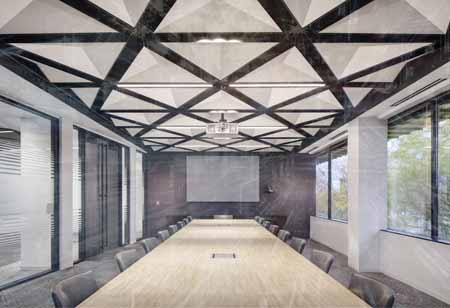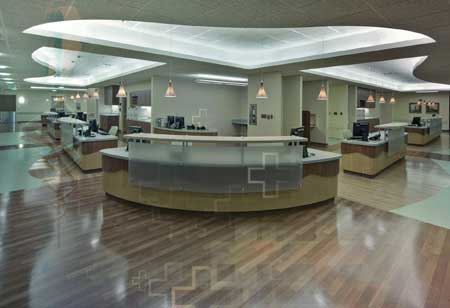THANK YOU FOR SUBSCRIBING

Versatility of Acoustic Ceiling Panels
Delilah Bennett, Research and Development Manager, Arup Group Limited

 Delilah Bennett, Research and Development Manager, Arup Group Limited
Delilah Bennett, Research and Development Manager, Arup Group LimitedAcoustic ceiling panels, crafted from mineral fiber and wood materials, bolster sound environments in diverse spaces.
FREMONT, CA: In the quest for building harmonious and functional spaces, the installation of acoustic ceiling panels has emerged as a potential solution. Acoustic ceiling panels serve as a remedy for spaces afflicted by excessive noise and echoes, providing a solution to bolster sound clarity. These customizable tiles, designed for installation on ceilings, effectively absorb sound, reducing excess noise, echoes, and reverberations within a room.
Manufactured using various materials, acoustic ceiling panels cater to distinct preferences and functional demands. Common materials include mineral fiber, fiberglass, wood, metal, and plastic. Mineral fiber, derived from rock, slag, or glass wool, forms semi-rigid or rigid panels referred to as mineral fiber panels. Particularly, mineral wool panels, crafted from basalt rock or steel slag waste, absorb sound waves due to their fibrous structure. Additionally, mineral wool panels provide thermal insulation and fire resistance, positioning them as optimal for various building interiors.
Fiberglass acoustic panels, tailored from fine glass fibers, share similar sound-absorbing properties with mineral wool counterparts. Lightweight and easy to install, these panels require additional fabric wrapping to prevent exposure to glass fibers. Appreciated for their natural aesthetic, wood panels deflect and absorb sound waves, fostering ambiance in spaces such as studios and theaters. Metal ceiling panels, formed from materials like aluminum or galvanized steel, offer durability, moisture resistance, and fire resistance, contributing to acoustic control and visual appeal. Plastic ceiling panels, made from recycled polyester fibers, present a cost-effective option, though they may have limited sound-dampening capabilities.
Diverse types of acoustic ceiling panels cater to particular design preferences and performance demands. Fabric-wrapped panels, paintable panels, wood panels, metal panels, and plastic tiles provide options for different tastes and budgets. The choice of wrapping materials encompasses microfiber, polyester, linen, cotton, vinyl, and microsuede, providing a spectrum of colors to coordinate with room aesthetics.
Acoustic ceiling panels transcend their sound-absorbing capabilities and elevate room functionality and aesthetics. Installation is typically straightforward, fitting into standard drop ceilings or using adhesive strips and wires for flexibility. The panels maintain easy access to the ceiling plenum, guaranteeing convenient maintenance.
These panels find applications in various settings, such as offices, conference rooms, home theaters, recording studios, restaurants, and schools. In office environments, they mitigate distractions by absorbing extraneous noise, bolstering productivity and focus. In conference rooms, acoustic panels control reverberation, enhancing presentation clarity. Classrooms benefit from low noise levels, aiding focus and comprehension. Home theaters harness these panels to contain sound leakage and optimize viewing clarity. Recording studios depend on them for echo reduction and sound isolation.
Choosing the right acoustic ceiling panels involves considering factors such as the Noise Reduction Coefficient (NRC), square footage for treatment, panel weight compatibility with ceiling grids, and compliance with safety codes. Visual coordination with interior design and adherence to regional building codes further guide the selection process.
Installation methods encompass overhead grid suspension, adhesive mounting, and hung suspension, each with its benefits and considerations. Lay-in panels on existing gridwork, adhesive mounting for direct attachment, and hung ceiling panels for floating aesthetics offer options tailored to various preferences and room architectures.
The future of acoustic ceiling panels holds promising investment opportunities as the demand for improved sound environments continues to increase. With a growing emphasis on workplace productivity, educational settings, and immersive entertainment spaces, the need for effective sound absorption solutions is pivotal. This opens unprecedented opportunities for Investors to capitalize on the rising market by exploring innovative materials, eco-friendly options, and smart technologies integrated into acoustic panels.
As sustainability gains significance, environmentally conscious solutions introduce a lucrative avenue. Furthermore, customization options for aesthetic appeal offer a niche for premium products. Investing in the dynamic sector of acoustic ceiling panels positions stakeholders at the forefront of a burgeoning industry.
Read Also


















ON THE DECK